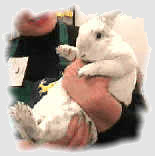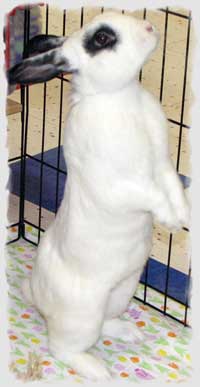
How are Rabbits Different from Cats & Dogs?
Rabbits are Prey Animals
Outdoor rabbits face many dangers from predators. They could be attacked by cats (both domestic and wild), dogs, wolves, and birds of prey such as hawks and falcons. Even raccoons attack rabbits. Rabbits are low on the food chain in the wild. They also can die simply from the stress of smelling or hearing a predator nearby - even if they aren't attacked.
This means rabbits have different needs and behaviors from a pet cat or dog. These behaviors become an advantage when your rabbit is kept as a house pet.
Rabbits Enjoy Having Their Own Space
Rabbits are comfortable in their "nest" which could be a cage or quiet, hidden corner of the room. They should have time to exercise & stretch everyday, but they can be just as happy sitting in their favorite corner. Be sure to give them toss & chew toys when they're in their cage so they exercise both their teeth & active, curious minds. Good toys include hard plastic baby keys & rattles and cardboard items.
Rabbits are used to being in enclosed areas for safety and security & confinement is not a punishment for them. Many species of wild rabbits dig extensive underground burrows and spend a lot of time underground. Claustrophobia doesn't exist in rabbits
Rabbits Prefer to Stay on the Ground Where They Have Control.
Being picked up can be scary for the rabbit. In nature being picked up is a similar event to being carried off by a hawk. To gain your rabbit's trust, start by sitting on the floor. She will eventually come over to investigate you. Be sure not to force any action that the rabbit doesn't want, such as making her sit in your lap. Later she may or may not be willing to do these things, but this should be on her timetable.
Rabbits are Active at Dusk & Dawn.
They are classified as crepuscular by zoologists. This means they are active at dawn & dusk to evade daytime and nocturnal predators. This is good for people with 8 to 5 schedules since this the time you are usually at home or getting ready for work. Rabbits typically rest during midday. However, they will adjust to whatever schedule you keep.
Rabbits are Creatures of Habit.
They learn and get used to a routine and stick to it, whether it is a feeding and exercise schedule or a place to eliminate. This aides litter box training tremendously. Rabbits choose to eliminate in corners where they have gone before. So if you keep a litter box in that corner they will train themselves. As they are allowed more access to your home keep many boxes available. Put a box where they prefer rather than making them go where you choose. Rabbits will venture into their new territory and drop their pills to act as a bookmark or trail of crumbs to find their way back to their nest. The way rabbits evade predators is to know every turn and hiding place in their range. Their favorite path is not necessarily the most direct.
They Neither Want nor Need Frequent Changes in Their Diet.
Rabbits' digestive system is easily upset. Be sure to keep hay (timothy or oat) available for them at all times. Feed them a consistent brand of high fiber (at least 15%) rabbit pellets. If you need to change their feed, mix an increasing percentage of the new feed with the current feed to slowly transition them to their new diet. Give them 1 cup of chopped veggies per day per 5 pounds of body weight. See our list of recommended veggies. Again, when you change or add new veggies, gradually increase the percentage of the new item to see if it agrees with your rabbit.
Rabbits are Sensitive to Heat & Can't do Much About it.
Domestic rabbits were originally bred from European wild rabbits. Europe is much cooler than California and the Sacramento valley. Their ideal climate is 60 to 70 degrees. This is one of the most important reasons to keep them indoors with you, especially in the valley summers. With their thick fur & tiny tongue, rabbits can't pant like dogs to keep cool. Rabbits' main cooling comes from their ears which act as radiators. Their ears have the largest amount of thin fur and exposed skin on their bodies. Pictures of Jackrabbits who live in the prairie & desert show enormous ears. In summer, keep a fan blowing past your rabbits, but not directly at them. They don't like drafts. They will begin to get uncomfortable beyond 80º. If it gets hot in your house, you can keep frozen water bottles for them to lie next to, or put ceramic tile in their cage or pen for them to lay on. You can also put ice cubes in their water crock.


